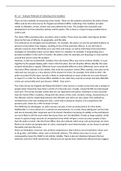AC 1.6 – Evaluate Methods of Collecting Crime Statistics
There are two methods of measuring crime trends. These are the statistics elected by the police (Home
Office) and by the Crime Survey for England and Wales (CSEW). Collecting crime statistics provides
trends in offenders, crimes, victims and areas affected by crime. This enables the evaluation and
development of crime reduction policies and the police. This is done in a hope to keep possible future
victims safe.
The Home Office provides police recorded crime in tables. These show recorded crime figures broken
down by the type of offence, its geography, and the date.
This method has its strengths and weaknesses. For example, the police can use the provided statistics to
prevent crimes before they happen, resulting in less of that particular offence. It can also help to
allocate resources more effectively as to save time and money, as well as informing crime prevention
strategies so immediate action can be taken where it is needed. For example, if drug dealing was a
prevalent problem in the north of London, the police could, for example, put drug dogs or more patrols
around that area to solve the problem.
However, it also has its downfalls. Statistics from the Home Office may not be entirely reliable. It is put
together by the people dealing with crime in the first place, but not all police officers identify the same
incident identically or equally. Different forces may identify different crimes differently, but in order for
the Home Office statistics to be reliable, they must be consistent. Home Office statistics may also not be
valid and may not give us a true picture of the amount of crime. For example, from 2016 to 2017, the
police recorded 45,000 rapes, but this is likely an underestimate as many victims do not come forward
to report it. In order for the Home Office statistics to be valid, they must be accurate and when 800,000
crimes are unrecorded each year [Source: HMIC] - they aren’t.
The Crime Survey for England and Wales/the British Crime Survey is a victim survey that asks a sample of
people what crimes they have been a victim of in the past year. Usually, around 50,000 are interviewed
each year. This survey includes crimes that are not reported to the police, meaning it is more accurate
than the Home Office’s statistics. Along with the nature of the crime, location, timing, characteristics of
the offender and the relationship between the offender and victim are also asked. This method has
revealed that in the year ending June 2021, crime had increased in total by 12% compared to the
previous year, driven by a 43% increase in fraud.
The CSEW has its advantages, as victim surveys can give a more accurate picture of crime levels.
Additionally, it is very ethical as it is carried out anonymously. As a result, those taking part can feel safe
and secure knowing their responses won’t be shared, therefore increasing its validity as the participants
are more likely to tell the truth when they know they can’t be identified. It looks at large samples, which
means it captures large amounts of unreported crime which will give a more accurate sample of data
than the police records. Like the Home Office, they also indicate which areas and social groups are most
likely to be victims and perpetrators of crime, meaning the most informed plan can be chosen to protect
the public and stop the crime.
There are limitations, however. One of these weaknesses is that it fails to record victimless crimes such
as drug sales, and hidden crimes such as domestic violence. This allows inaccuracy to occur, and
consequently means the CSEW is not entirely reliable. There is also an imbalance between the two
methods, since the CSEW reveals that criminal acts are spread more widely than official surveys suggest.





